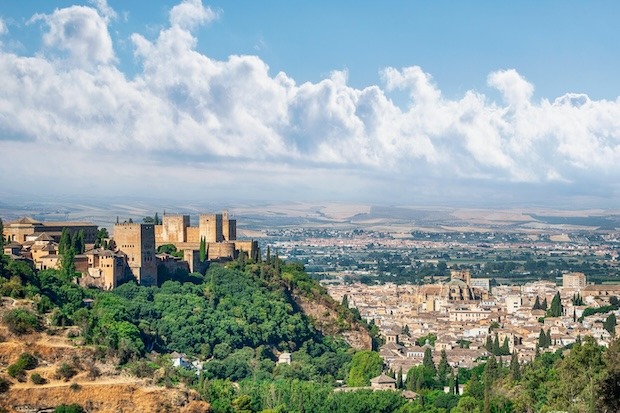Day 1: Alhambra and the Lower City
Morning: Start your Granada adventure at the majestic Alhambra, the city’s most iconic site and one of Spain’s most visited monuments. Arrive early—ideally by 8:30 AM—to beat the crowds and enter the Nasrid Palaces during your reserved time slot. Wander through the intricately decorated Patio of the Lions, marvel at the geometric tilework, and take in the calm of the Court of the Myrtles. Continue to the Generalife Gardens, where flower-filled walkways and fountains frame sweeping views of the city below. Cap off your Alhambra visit with a climb up the Alcazaba fortress for unbeatable views of the Sierra Nevada and the rooftops of Granada.
Afternoon: Descend from the Alhambra toward Plaza Nueva, Granada’s central and historic square, bustling with locals and travelers alike. Just steps away is the grand Granada Cathedral, a striking mix of Gothic, Renaissance, and Baroque architecture. Directly attached is the Royal Chapel of Granada, the final resting place of Ferdinand and Isabella, whose tombs lie in beautifully carved marble coffins. Take time to admire the art and symbolism found throughout.
Next, step into the Alcaicería, the old Moorish silk market turned maze-like bazaar. The narrow alleys are filled with souvenir stalls, intricate lanterns, and hand-painted ceramics. It’s touristy but undeniably atmospheric and makes for a fun wander.
Evening: As the sun sets, enjoy a gentle stroll along the Carrera del Darro, one of Granada’s most scenic streets. With cobblestones underfoot and the Darro River to your side, this walk offers glimpses of ancient bridges, Moorish facades, and the Alhambra perched high above. Continue to Paseo de los Tristes, a romantic promenade beneath the Alhambra’s walls. Dine nearby or head back toward Realejo for an alfresco dinner.

Save Tip:
Book your Alhambra tickets directly through the official Patronato de la Alhambra website. This avoids inflated third-party prices and guarantees access to the Nasrid Palaces, which sell out quickly.

Splurge Tip:
Join a small-group or private Alhambra tour for a deeper understanding of the architecture and legends—from secret passageways to royal intrigues.
Day 2: Albaicín and Sacromonte
Morning: Head to the ancient Albaicín neighborhood, a UNESCO World Heritage Site that captures Granada’s Moorish soul. Begin at the Mirador de San Nicolás, where you’ll get jaw-dropping views of the Alhambra framed by the snowy Sierra Nevada. Get there early for great lighting and fewer crowds.
Wander down Calle Calderería Nueva, also known as the “tea street,” for its Moroccan-style teterías, hookah lounges, and shops selling everything from spices to leather goods. It feels like a slice of North Africa transplanted into southern Spain.
Afternoon: Delve deeper into Moorish Granada with visits to El Bñuelo, a beautifully preserved 11th-century Arab bathhouse, and Casa Horno de Oro, a Nasrid home turned museum. Both give fascinating glimpses into everyday life during Islamic rule.
Then make your way into Sacromonte, a hillside neighborhood known for its cave houses and flamenco heritage. The Cuevas del Sacromonte Museum brings this history to life with reconstructions of cave dwellings and exhibits on Gitano culture. If you have the energy, continue to the Abbey of Sacromonte for peaceful gardens, catacombs, and sweeping vistas.
Evening: Stay in Sacromonte after dark for a fiery flamenco show in a cave venue. The intimacy of these performances, often limited to 30 or 40 people, makes it feel like the dancers are performing just for you. Book in advance and soak in the passion and percussion.

Save Tip:
Use the C31 or C32 minibuses to reach Albaicín and Sacromonte. They’re affordable, reliable, and much easier than hiking up steep hills.

Splurge Tip:
Opt for a flamenco dinner experience in a historic cave, complete with sangria and terrace views of the illuminated Alhambra.
Day 3: Realejo and Hidden Gardens
Morning: Begin in Realejo, Granada’s former Jewish quarter. It’s quieter than the tourist hotspots but rich with charm. Walk down Calle Pavaneras, where graffiti murals by local artist El Niño de las Pinturas give the district a colorful, contemporary edge.
Make your way to Carmen de los Mártires, a romantic estate tucked behind the Alhambra grounds. Its formal gardens, whimsical fountains, and peacocks create a tranquil escape. The views alone make this one of Granada’s best-kept secrets.
Afternoon: Descend to Campo del Príncipe, a peaceful plaza shaded by tall trees. Grab a bench, enjoy a snack, and watch daily life unfold around you. Then head to the Museo de Bellas Artes, located inside the Palacio de Carlos V. If you missed it on Day 1, now’s your chance to explore this lesser-known gem filled with regional art and religious relics.
Evening: Wrap up your final day on one of Granada’s many rooftops. Whether it’s near Campo del Príncipe or just outside Realejo, you’ll find plenty of spots offering cocktails with views. Watch as the sun sets and the Alhambra lights up in golden tones—a magical farewell to this Andalusian treasure.

Save Tip:
Visit Carmen de los Mártires and Museo de Bellas Artes, both of which are free to enter and offer a peaceful, culturally rich experience.

Splurge Tip:
Book a sunset rooftop experience with craft cocktails or guided tastings. Some include a live guitar performance for an extra dose of Andalusian magic.
Day 4: Daytrip to Cordoba
Morning:
Take an early high-speed train from Granada to Córdoba—a 1.5-hour journey that whisks you into another treasure of Andalusia. Begin at the magnificent Mezquita-Catedral, a stunning architectural fusion of Islamic and Christian styles. Wander under its famous striped arches and admire the Renaissance cathedral built right inside the original mosque.
Afternoon: From there, stroll through the Jewish Quarter (Judería), where whitewashed buildings, cobbled alleys, and flower-filled patios await. Visit the Synagogue of Córdoba, one of the few historic synagogues still standing in Spain, and peek into the Casa de Sefarad museum to better understand the city’s Sephardic Jewish heritage.
Stop by the Alcázar de los Reyes Cristianos, with its expansive gardens and ancient Roman mosaics, then cross the historic Roman Bridge of Córdoba, with scenic views back toward the Mezquita.
Evening: Before catching your evening train back to Granada, take time to unwind with a leisurely walk or dinner in Plaza de las Tendillas. If you have time, enjoy a coffee or snack at a shaded café and reflect on the day’s sights.

Save Tip:
Buy a combo ticket that includes entrance to multiple sites like the Mezquita and Alcázar, saving you money and time.

Splurge Tip:
Take a private walking tour of the Mezquita and Jewish Quarter to gain deeper insights into Córdoba’s layered religious and cultural history.

Granada is one of the last cities in Spain where tapas are still free with every drink. Order a small beer or wine at any bar and you’ll get a complimentary dish! One of the very few times where bar-hopping feels like saving than splurging.

